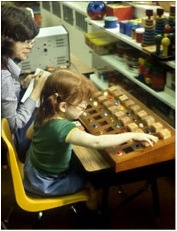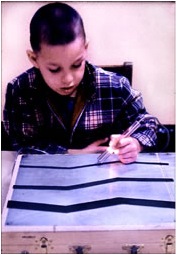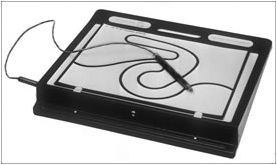Excerpt from
Engineering design education and rehabilitation engineering
Robert W. Mann, ScD, Whitaker Professor Emeritus, Biomedical Engineering
Department of Mechanical Engineering, Massachusetts Institute of Technology, Cambridge, MA
"TOYS" FOR REHABILITATION
By the early 1970s, our rehabilitation engineering efforts had achieved high visibility at MIT through the many students, mostly upper-class undergraduate and graduate students, who were contributing to it. Increasingly freshmen and women would ask if they could get involved, but I was wary, given their likely inexperience, both in relevant coursework and in making things. But I met an occupational therapist at a local children’s rehabilitation hospital who welcomed the idea of setting our MIT students to the task of devising devices which the disabled children would see as toys, but which could also provide some rehabilitative benefit and/or augment the efforts of the occupational and physical therapists.
The Creative Technological Aids (CTA) program was led by Mary Driscoll at the Kennedy Memorial (now Franciscan) Hospital and Professor Roger Kaufman and colleagues at MIT [27]. Immensely popular at both institutions, CTA produced dozens of clever devices, the invention of which challenged the MIT fresh women and men who designed and built them, while delighting the children at the hospital who played with and benefited from them. The perceived utility of some of the “toys” was such that we formed a nonprofit organization, CTA, Inc., to explore small-scale manufacture and marketing of selected devices.
Several of the toys and their originators are illustrative of the effectiveness of CTA. Dennis W. Burke, even as a freshman, dispelled my concerns with respect to fabrication ability.* A skilled craftsman, he designed and made two toys based on alphabet blocks in the MIT Hobby Shop. Each had unique coded contacts such that block placement would only close a circuit when properly oriented in the receptacle corresponding to that letter. “Bright Blocks” (Figure 5) had a receptacle for each of the 26 alphabetical letters. Correct placement and orientation of the appropriate block illuminated the lamp below the receptacle. “Flash Word” used the same blocks, but now the therapist drew a cartoon intended to invoke a word response, then punched the paper at the bottom of the cartoon with the code for the correct blocks. Only if the child placed the blocks so as to correspond to the word would the music box play!
*Dennis W. Burke, MD, is now an orthopedic surgeon at the Massachusetts General Hospital, specializing in total joint replacement.

Figure 5. Child at the Kennedy Memorial Hospital in Brighton, Massachusetts "playing" with the rehabilitation toy "Bright Blocks," observed by an occupational therapist.
Mindy Lipson was as inexperienced as I had worried fresh persons would be.* However, by observing the therapists strengthen the eye-hand coordination of the the youngsters in one-on-one training, she conceived a toy to free the therapist while the child practiced. She called it “Magic Light Pen” (Figure 6). Only if the child kept the pen on the poster paper strip would the light in the pen stay on, providing positive reinforcement; at the end of a path the bell would ring, signifying a successful hand-eye tracing task. Figure 7 is the production prototype of Magic Light Pen fabricated by Goodwill Industries of Harrisburg, Pennsylvania.
*Mindy Lipson Aisen, MD, is now a board-certified neurologist and Director of the Rehabilitation Research and Development Service of the U.S. Department of Veterans Affairs.

Figure 6. Child at the Kennedy Memorial Hospital in Brighton, Massachusetts practicing hand-eye coordination with the rehabilitation toy "Magic Light Pen."

Figure 7. The "commercial" prototype of Magic Light Pen developed at Goodwill Industries, Inc., Harrisburg Pennsylvania.